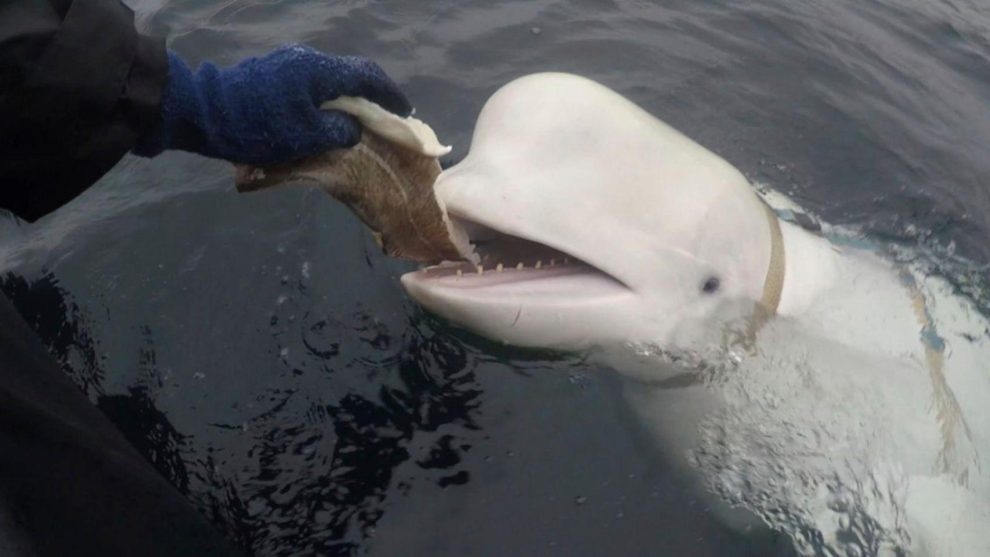A beluga or white whale of which had suspected that she could be a “spy” for Russia in Norway was found dead last Saturday in Stavenger, the west coast of this Nordic country, reported EfeThe whale will undergo an autopsy on Monday to determine the cause of its death, the Sandnes Veterinary Institute announced. OneWhale, an organisation whose mission was to protect the beluga and advocated for its release so that it could live with other whales in the future, does not believe it died of natural causes.
“Hvaldimir” -as he was baptized in his day combining the word hval (whale) and the name of the Russian president, Vladimir Putin– was first seen in 2019 in several Norwegian locations and attracted attention for its docility.
When a strap holding a camera was found on its back with the label “St. Petersburg equipment,” speculation arose as to whether it could be a “spy” whale, due to its ability to collide with ships, interact with salmon fishermen and even stealing (and returning) GoPros that had been lost in the oceanOther experts pointed to its possible use in therapies for troubled children.
[Un delfín en busca de pareja atemoriza a Japón: le acusan de hasta 18 ataques a bañistas]
In Norway, Hvaldimir became a celebrity attracting up to 300 tourists per day. OneWhale then claimed that the whale had sparked an unregulated tourism industry, with diving instructors and tour operators selling group trips to swim and dive with it.
Tourism caused him visible stress because people They offered him harmful objects and sometimes put them in his mouth. The animal suffered life-threatening injuries to its teeth and mouth as a result. It has repeatedly encountered boat propellers and sharp objects, OneWhale reports.
On Facebook, the organization wrote that it was angry, very upset and “heartbroken” because after years of fighting to “help him out of danger,” Hvaldimir was finally “close to having a better life.” However, “there is a group of humans who wanted to keep him trapped and prevented this sweet animal from receiving help sooner. They will receive all the credit for their premature deathThe average lifespan of belugas is between 35 and 50 years. Hvaldimir was 15 years old when he died.
In fact, belugas, while not endangered, are a protected species under the Marine Mammal Protection Act. The International Fund for Animal Welfare (IFAW) indicates that some of the threats they face include: captivity; the hunt and the fishing; the pollution; the pollution acoustics; and any activity related to human activityThey were also hunted (like seals) for their oil, meat and fur during the 19th and 20th centuries. They are still hunted in the Arctic today.
A lonely beluga
Hvaldimir was a displaced marine mammal that frequented areas with human presence. It did not have a feral behavior, but rather behaved like a domestic animal. lost or abandoned. He sought out people rather than avoiding them, OneWhale said.
According to IFAW, belugas are very social animals that do not normally live alone. They live in herds or groups made up of family and friends.The average size of these is 10, although they can include up to 25 individuals.
Before he died, Hvaldimir was taken to a fjord in eastern Finmark, where authorities hoped he could integrate with other specimens of his species.
Animals trained since the Cold War
During World War II, the United Kingdom trained sea lions without much success. Speculations of espionage of marine animals date back to the Cold War. Both the United States and the Soviet Union trained belugas, dolphins, sea lions, fur seals, sharks, rays, turtles and seabirds for their sensory and physical abilities.
The Soviet strategy was that belugas, dolphins, sea lions and fur seals They will search for underwater mines and other objects under the sea. After the collapse of the Soviet Union, Time indicates that The dolphins were sold to Iransince the marine mammal training program was suspended.
Today the Russians have trained military dolphins to solve different tasks, from analyzing the ocean floor to killing foreign divers and placing mines on the hulls of foreign ships to protect a stretch of water. The dolphin facility is located in Sevastopol, Crimea, and was under Ukrainian control before 2014.
In 2016, a new program under the supervision of the Russian Ministry of Defense began looking for new recruits to train combat dolphins and seals for the Russian Navy. In fact, Time indicates that offered up to $24,000 for five bottlenose dolphins.
The Marine Mammal Program in the United States currently trains bottlenose dolphins and California sea lions to detect, locate, mark and recover objects (and threats) in ports, coastal areas and the open ocean, explains the Naval Information Warfare Center Pacific (NIWC Pacific). Threats include explosives, mines, (enemy) divers and manned or unmanned surface or subsurface vessels, specifies the US State Department.
Nowadays, marine animals are not only used as spies by different governments and are therefore subject to other dangers. Cetaceans, for example, are victims of military experiments. Animal Ethics He claims that armies sometimes test the effects of their new weapons on moving targets and therefore attack animals.
The objective is observe the resistance of the animals’ bodies to attacks or extreme situations that the soldiers themselves may suffer during conflicts. In addition, animals can also be surgical experiment subjects so that military doctors can learn how to treat weapons wounds and their healing capacity.



![[Img #74675]](https://thelatestnews.world/wp-content/uploads/2024/12/They-discover-a-new-class-of-X-ray-sources-in-the-150x150.jpg)










Add Comment